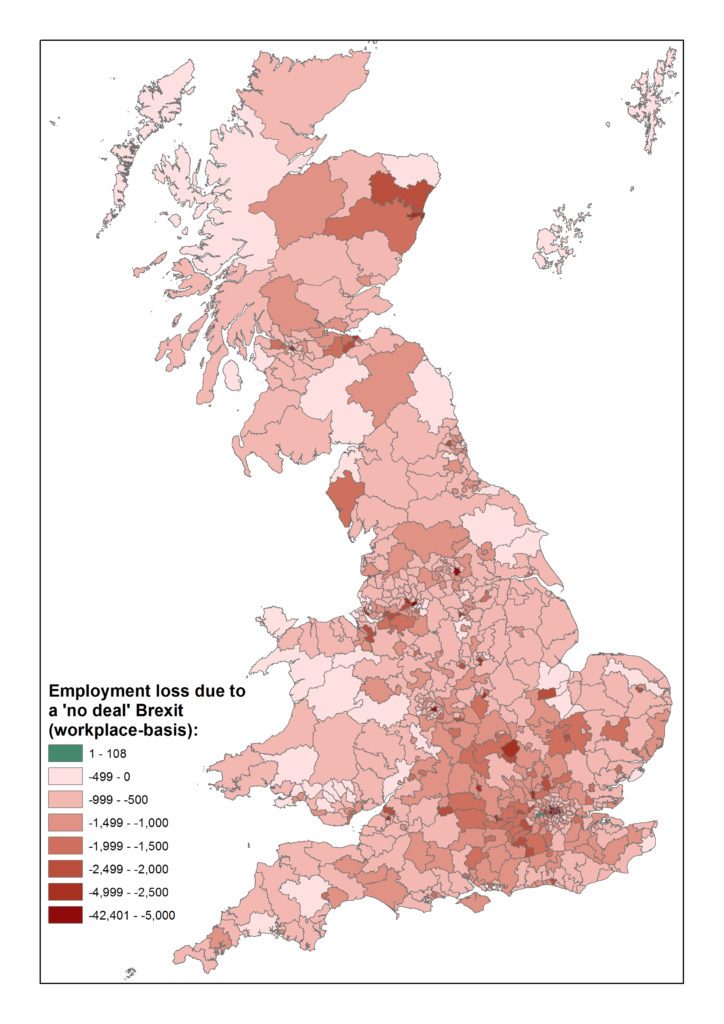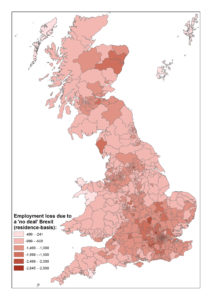The vulnerability of different parliamentary constituencies to Brexit economic shocks
Written by: Nick Phipps

 10 December 2018
10 December 2018
L. Alan Winters CB, Professor of Economics and Director of the UK Trade Policy Observatory and Ilona Serwicka is Research Fellow in the economics of Brexit at the Observatory.
Today we are publishing a study of the economic impact of ‘no deal’ and ‘soft’ Brexit scenarios on the 632 Parliamentary constituencies in Great Britain. It shows that calculating the effect of Brexit on the residents in an area gives a very different perspective from the more common calculation based on the jobs in that area.
For example, a ‘no deal’ Brexit would imply a shock equivalent to losing some 42,400 jobs in the parliamentary constituency of Cities of London and Westminster. However, 41,250 of these jobs are held by people who live elsewhere. At the other extreme, Streatham may suffer a loss equivalent to 650 of its jobs, but around 2,250 of Streatham’s residents would lose their employment.
Our estimates are conservative. They suggest that failing to secure a close trading relationship with the EU will give the UK economy a shock equivalent to losing a total of about 750,000 jobs (only about half the value implied by the government’s own estimates of 28th November). We find that, while those job losses will tend to be concentrated in cities and large towns, the people whose jobs they are, tend to live over much larger surrounding areas.
Presenting Brexit effects by area of residence is important because people typically spend more where they live than where they work. This means that the impact of Brexit on any constituency is captured more appropriately by studying the possible job losses among residents of that constituency rather than among workers in that constituency. Once we look at Brexit on a residence basis, we see that its economic costs are less concentrated but far more widespread than one would guess from the pattern of employment around the UK in terms of workplaces. While 269 constituencies will suffer shocks equivalent to losing more than one thousand jobs on a workplace-basis, 398 will do so on a residence-basis.

No deal Brexit on jobs – defined by workplace

No deal Brexit on jobs – defined by place of residence
Constituency-level results are particularly important at present because Parliament, and hence the views of individual MPs, will play a key role in making Brexit decisions as part of the imminent ‘meaningful vote’. Our results will help MPs and the people who vote for them to gauge, albeit approximately, one aspect of their economic interest in the outcome of Brexit.
The complete set of results that measure the Brexit shock in terms of possible job losses among workplaces and residents of the 632 parliamentary constituencies in Great Britain, along with a more detailed discussion of them, is available is this note. We give results for a ‘no deal’ Brexit and a ‘soft’ Brexit which assumes that the UK maintains much closer links with the EU economy.
This study is a follow-up to our recent analysis of the impact of Brexit on the 34 parliamentary constituencies in Hampshire and Sussex published on 21 November 2018. That publication explains exactly how the estimates are derived and how to interpret them.
Disclaimer:
The opinions expressed in this blog are those of the author alone and do not necessarily represent the opinions of the University of Sussex or UK Trade Policy Observatory.
Republishing guidelines:
The UK Trade Policy Observatory believes in the free flow of information and encourages readers to cite our materials, providing due acknowledgement. For online use, this should be a link to the original resource on our website. We do not publish under a Creative Commons license. This means you CANNOT republish our articles online or in print for free.

Brilliant! Yes, I do believe Prof Winters has the answer with this. I would suggest that a special effort is made to get a high turnout especially in the first referendum. I’m afraid that some remainers may feel it’s not for them (“plague on both your houses”) but if they don’t vote they could end up with a no-deal brexit. All three campaigns (Remain, May’s deal, and No deal) would campaign in parallel for their preferred options. Allocating spending limits would be tricky, as there’s no symmetry between the three options. Maybe in the proportion of, say, REMAIN £3m; DEAL £2m; NO DEAL? It could either be left to each campaign to decide how much of their allowance they hold back for the second referendum, or distinct spending limits could be set for each referendum.
(I earlier suggested having both votes on the same day, on a single paper. There are some subtle advantages to this, but it would require THREE questions, and would, I think, on balance be too complicated).
Is it possible that you could share how you acquired the data/estimates for the number of jobs affected?
[…] 6 percent of the UK’s population — 3.7 million people — are EU citizens. A recent study projects that 400,000 to 750,000 people could lose their jobs as a result of Brexit. The change […]
It is incredible that these projections have not been seriously debated in Parliament or in the media. These are the consequences of renunciation of our European Treaties.
If the unthinkable renunciation occurs without a Withdrawal Treaty how long will it be before new Treaties with non EU states are in place and how many more jobs will be lost on the altar of Machiavellian populism?
Is there further information on how these maps were developed?
Is there a site or article that shows what the types of economic activity are in each constituency and how these are affected?
Where are the IMPACT ASSESSMENTS OF …No Deal and .. leaving the EU with Mays deal? Can it be shown how different sectors of our economy will be affected by No Deal and May’s dea?
Dear Gavin,
Thank you for your comment.
For more information about how the estimates are derived and how to interpret them, please see Briefing Paper 26: The Brexit Burden: A constituency level analysis for Hampshire and Sussex and the accompanying online appendix.